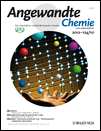Reagent-Installed Capsule Network: Selective Thiocarbamoylation of Aromatic Amines in Crystals with Preinstalled CH3NCS†
This research was supported by the CREST project of the Japan Science and Technology Agency (JST), for which M.F. is the principal investigator, and also in part by KAKENHI (20044006), JSPS, and Global COE Program (Chemistry Innovation through Cooperation of Science and Engineering), MEXT (Japan). Y.I. thanks Kurata Grants for younger scientists.
Graphical Abstract
Kristalline Reagenskapseln wurden durch Einbringen von CH3NCS in vernetzte molekulare Kapseln erzeugt. Die feste Verkapselung verhindert zunächst ein Auslaugen von Reagensmolekülen in die Lösung, und erst beim Eindringen von Aminen in die interstitiellen Poren wird das Reagens freigesetzt. Das Ergebnis ist eine gesteigerte Substratselektivität in der Festkörper-Thiocarbamoylierung (siehe Bild; 86:14 zugunsten von 2- gegenüber 1-Naphthylamin).






